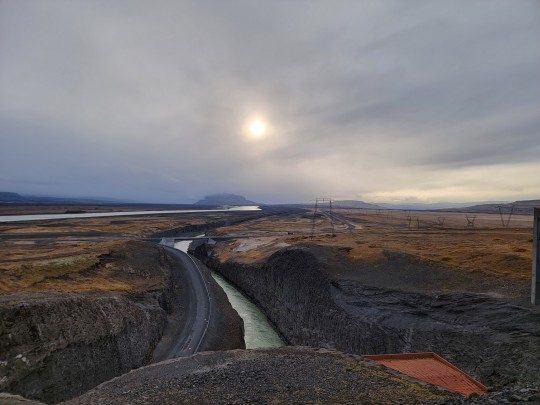#Hydroelectric Projects
Explore tagged Tumblr posts
Text
Milestone Achieved: 70% Work Done on 400 kV Bahrabise Substation
Kathmandu, Dec. 2: The construction of a 400 kilovolt (kV) substation in Bahrabise Municipality of Sindhupalchowk is going on in full swing. The construction of the 400 kV Bahrabise substation has been started to transmit electricity from the hydroelectric projects to be built on the Tamakoshi and Sunkoshi rivers and their tributaries to the national transmission system and to strengthen the…
#Bahrabise Substation#Hydroelectric Projects#Millennium Challenge Corporation (MCC)#national transmission system
0 notes
Text
Russia. Svir River. Upper Svir Hydroelectric Station, lock Свирь. Верхнесвирская ГЭС, шлюз
#2016#hydroelectric station#july#leningrad oblast#lock#motorship#project 302#river#river passenger ships#russia#ship#summer#svir river#upper svir hydroelectric station#верхнесвирская гэс#гэс#июль#ленинградская область#лето#проект 302#река#россия#свирь#теплоход#теплоход михаил шолохов#шлюз#электростанция#power station#flickr#russian tumblr
10 notes
·
View notes
Text

Sultartangavirkjun Hydroelectric Plant - October 7th 2023
#notice how deep they dug an outflow? this is a large infrastructure project in the middle of nowhere#there's a bigger dam up river iceland has a habit of trying to contain glacial melt flows#this scale is common in greenland which is why i was here...parallel research#iceland#highlanda#hydroelectric infrastructure#renewableenergy
10 notes
·
View notes
Text




Finally got to making a Legendary group i wanted to make since i tapped into the South Kalos project! And it's based on unused content in X and Y and a callback to it 6 years later in Sword and Shield where they introduce a nuclear space whale dragon skeleton... thing. these thing all have like 570 total base stat since i forgot to mention that back on dA

Eternamikos || Eternawirl Eternaventi || Eternafurna Make sure to check these links out before you go! Please...?
-Twitter-
-Tumblr-
-DeviantArt-
-Newgrounds-
-FurAffinity-
-Discord Channel-
#pokemon#fakemon#pokemon xy#poison type#steel type#electric type#psychic type#fire type#eternatus#pokemon swsh#south kalos project#geothermal#hydroelectricity#wind energy#fossil fuels
8 notes
·
View notes
Text

i am- very aware that i dont draw often- trust me- wish i could- pretty sure my art is regressing-love it
he's dating aquaman
#my art#art#digital drawing#digital art#superhero#this was for a science project#idk man#hydroelectric
9 notes
·
View notes
Text
शानन जल विद्युत परियोजना लीज मामले में सर्वोच्च न्यायालय जाएगी प्रदेश सरकार; सीएम सुक्खू
शानन जल विद्युत परियोजना लीज मामले में सर्वोच्च न्यायालय जाएगी प्रदेश सरकार; सीएम सुक्खू #news #viral #trending #update #newspaper #breakingnews #currentaffairs #dailynews #newsletter #newspapers #newsupdate #People #Media #info #Journalism #Press
Shimla News: मुख्यमंत्री सुखविंद्र सिंह सुक्खू ने शनिवार को ऊर्जा विभाग के अधिकारियों के साथ हुई बैठक की अध्यक्षता करते हुए प्रदेश के लोगों को अधिकतम लाभ पहुंचाने के लिए हिमाचल प्रदेश के उचित दावों को न्यायालय में पेश करने की आवश्यकता पर बल दिया। उन्होंने कहा कि जोगिंद्रनगर में 110 मेगावाट की शानन जल विद्युत परियोजना को हिमाचल प्रदेश को सौंपा जाना चाहिए, क्योंकि पंजाब के पक्ष में इस परियोजना की…
0 notes
Text
Jhakri-Rampur Bushahr: Natural Beauty, Heritage, and Innovation in Himachal Pradesh

View On WordPress
#1500 MW#Bhimakali Temple#dense forests#green hills#Himachal Pradesh#Jhakri#lavi fair#Nathpa Jhakri Hydroelectric Project#Padam Palace#rampur#Rampur Bhushahr#Satluj river
0 notes
Text
The Klamath River’s salmon population has declined due to myriad factors, but the biggest culprit is believed to be a series of dams built along the river from 1918 to 1962, cutting off fish migration routes.
Now, after decades of Indigenous advocacy, four of the structures are being demolished as part of the largest dam removal project in United States history. In November, crews finished removing the first of the four dams as part of a push to restore 644 kilometres (400 miles) of fish habitat.
“Dam removal is the largest single step that we can take to restore the Klamath River ecosystem,” [Barry McCovey, a member of the Yurok Tribe and director of tribal fisheries,] told Al Jazeera. “We’re going to see benefits to the ecosystem and then, in turn, to the fishery for decades and decades to come.” ...
A ‘watershed moment’
Four years later, [after a catastrophic fish die-off in 2002,] in 2006, the licence for the hydroelectric dams expired. That created an opportunity, according to Mark Bransom, CEO of the Klamath River Renewal Corporation (KRRC), a nonprofit founded to oversee the dam removals.
Standards for protecting fisheries had increased since the initial license was issued, and the utility company responsible for the dams faced a choice. It could either upgrade the dams at an economic loss or enter into a settlement agreement that would allow it to operate the dams until they could be demolished.
“A big driver was the economics — knowing that they would have to modify these facilities to bring them up to modern environmental standards,” Bransom explained. “And the economics just didn’t pencil out.”
The utility company chose the settlement. In 2016, the KRRC was created to work with the state governments of California and Oregon to demolish the dams.
Final approval for the deal came in 2022, in what Bransom remembers as a “watershed moment”.
Regulators at the Federal Energy Regulatory Commission (FERC) voted unanimously to tear down the dams, citing the benefit to the environment as well as to Indigenous tribes...
Tears of joy
Destruction of the first dam — the smallest, known as Copco 2 — began in June, with heavy machinery like excavators tearing down its concrete walls.
[Amy Cordalis, a Yurok Tribe member, fisherwoman and lawyer for the tribe,] was present for the start of the destruction. Bransom had invited her and fellow KRRC board members to visit the bend in the Klamath River where Copco 2 was being removed. She remembers taking his hand as they walked along a gravel ridge towards the water, a vein of blue nestled amid rolling hills.
“And then, there it was,” Cordalis said. “Or there it wasn’t. The dam was gone.”
For the first time in a century, water flowed freely through that area of the river. Cordalis felt like she was seeing her homelands restored.
Tears of joy began to roll down her cheeks. “I just cried so hard because it was so beautiful.”
The experience was also “profound” for Bransom. “It really was literally a jolt of energy that flowed through us,” he said, calling the visit “perhaps one of the most touching, most moving moments in my entire life”.
Demolition on Copco 2 was completed in November, with work starting on the other three dams. The entire project is scheduled to wrap in late 2024.
[A resilient river]
But experts like McCovey say major hurdles remain to restoring the river’s historic salmon population.
Climate change is warming the water. Wildfires and flash floods are contaminating the river with debris. And tiny particles from rubber vehicle tires are washing off roadways and into waterways, where their chemicals can kill fish within hours.
McCovey, however, is optimistic that the dam demolitions will help the river become more resilient.
“Dam removal is one of the best things we can do to help the Klamath basin be ready to handle climate change,” McCovey explained. He added that the river’s uninterrupted flow will also help flush out sediment and improve water quality.
The removal project is not the solution to all the river’s woes, but McCovey believes it’s a start — a step towards rebuilding the reciprocal relationship between the waterway and the Indigenous people who rely on it.
“We do a little bit of work, and then we start to see more salmon, and then maybe we get to eat more salmon, and that starts to help our people heal a little bit,” McCovey said. “And once we start healing, then we’re in a place where we can start to help the ecosystem a little bit more.”"
-via Al Jazeera, December 4, 2023
#indigenous#river#riverine#ecosystem#ecosystem restoration#klamath#klamath river#oregon#california#yurok#fishing#fisheries#nature is healing#literally this time lol#united states#dam removal#climate change#conservation#sustainability#salmon#salmon run#water quality#good news#hope#rewilding#ecology#environment
5K notes
·
View notes
Text
Things Biden and the Democrats did, this week #3
Jan 26-Feb 2 2024
The House overwhelmingly passed a tax deal that will revive the expanded Child Tax Credit, this will effect 16 million American children and lift 400,000 out of poverty in the first year. The deal also supports the building of 200,000 housing units over the next two years, and provides tax relief for communities hit by disasters.
The Biden Administration has begun negotiations on drug prices for Medicare. Earlier this year the administration announced it would negotiate for the first time directly with drug manufacturers on the prices of 10 common medications. This week they sent their opening offers to the companies. The program is expected to save Medicare and enrollees billions over dollars over the long term and help push down drug prices for everyone.
The Department of Transportation has green lit $240 Million to modernize air ports across the country. Air Ports in 37 states will be able to get much needed updates and refurbishment.
The Biden Administration announced 10 sites across America as sites for innovation investment. They will receive up to 2 billion dollars each over the next 10 years. The goal is to stimulate economic growth and innovation in semiconductor manufacturing, clean energy, sustainable textiles, climate-resilient agriculture, regenerative medicine, and more.
The State Department reviews options for recognizing Palestinian Statehood. While as of yet there's been no policy change this review of options is a major shift in US diplomatic thinking which has long opposed Palestinian Statehood and shows a seriousness of reported Biden plans to push for Statehood as part of a post-war Israel-Saudi normalization deal.
President Biden imposes sanctions on Israeli settlers who have engaged in violence against Palestinians and peace activists. This marks the first time the US has leveled sanctions against Israelis and sets up a standard that could see the whole settlement movement cut off from the US financial system
the Department of Energy has tentatively agreed to a $1.5 Billion dollar loan to help reopen a Michigan nuclear power plant. This would mark the first time a closed nuclear plant has been brought back online. Closed in 2022 it's hoped that it could reopen in time to be generating power in late 2025. This is part of Biden's plan to decarbonize the electricity grid by 2035.
the Internal Revenue Service launched a program to allow tax fillers file for free directly with the government. In 2024 its a pilot program limited to 12 states, but plans for it to be nation wide by tax day 2025
The Department of Health and Human Services announced $28 million in grants to help with the treatment of substance use disorder, including a program aimed at pregnant and postpartum women, and expanded drug court aimed at directing people into treatment and out of the criminal justice system.
The Department of Energy announced $72 million for 46 hydroelectric projects across 19 states. This marks the single largest investment in Hydropower in US history.
The Senate confirmed President Biden's 175th federal judge. Biden has now appointed more federal judges in his first term in office than President Obama did in his, however still lags behind Trump's 186 judges. For the first time in history a majority of a President's nominees are not white men, 65% of them are women and 65% are people of color, President Biden has appointed more black women to judgeships than any administration in history.
#Joe Biden#Thanks Biden#good news#us politics#politics#Democrats#Poverty#Climate change#nuclear power#Israel#israeli settlers#Palestine#israel palestine conflict
804 notes
·
View notes
Text
The Merowe Dam, built along the Nile River in Sudan, is the largest hydroelectric project in Africa. River diversion began in 2004, with construction finishing in 2009. Upon completion, the dam doubled Sudan’s electricity supply. As the dam backed up and expanded the flow of the river into a reservoir, the surface area of the Nile increased roughly 270 square miles (699 square kilometers) and displaced 70,000 indigenous people who relied on the land for farming. Because of the warm climate in the region, combined with this increase in surface area, the reservoir is now experiencing evaporation losses of 396.3 billion gallons (1.5 billion cubic meters) of water every year, roughly 8 percent of the water allocated to Sudan from the 1959 Nile Waters Treaty.
18.668889°, 32.050278°
Source imagery: NASA / Google Timelapse
86 notes
·
View notes
Text
Finance Minister Paudel: Government Will Create an Environment to Attract Foreign Investment in Hydropower
Kathmandu — Deputy Prime Minister and Finance Minister Bishnu Paudel stated that the government will create an environment to attract foreign investment in Nepal’s energy sector. Speaking at the ‘Unlocking Investment’ program organized jointly by the Independent Power Producers’ Association of Nepal (IPPAN) and Upaya in Kathmandu on Wednesday, Minister Paudel emphasized the need to make the…
#Bishnu Paudel#Ganesh Karki#Hydroelectric Projects#International Finance Corporation#IPPAN#Nepal’s energy sector
0 notes
Text
Russia. Don River. Volgo-Don 189 Дон. Волго-Дон 189
#2018#may#spring#весна#май#Russia#Rostov Oblast#Россия#Ростовская область#Don River#Дон#река#river#Tsimlyansk hydroelectric power plant#lock No. 15#lock#Цимлянская ГЭС#шлюз № 15#шлюз#Волго-Дон 189#Волго-Дон#Volgo-Don 189#Volgo-Don#general cargo#project 507Б#ship#проект 507Б#судно#сухогруз#flickr
2 notes
·
View notes
Text
A Key Part of Biden’s Climate Law Was Built to Survive Trump. Now, the Test. (New York Times)
Excerpt from this New York Times story:
One of the most powerful parts of President Biden’s signature climate law was designed to attract support from such a wide array of industries that it would be hard for Congress to repeal.
Now, that theory is about to be tested.
This month, the federal government will begin offering lucrative tax credits to companies that build wind, solar, nuclear, geothermal or other new sources of electricity that don’t generate any of the greenhouse gases that are rapidly heating the planet.
While tax breaks for companies that build wind farms and solar panels have existed for years, these new credits can apply to a much wider set of technologies, including nuclear reactors, advanced geothermal plants, fusion plants, hydroelectric dams, novel types of batteries and much more. The so-called “technology neutral” clean electricity tax credits, which Congress passed as part of the 2022 Inflation Reduction Act, are projected to do more than any other policy in the coming years to reduce America’s greenhouse gas emissions.
“These policies are nothing short of an energy moon shot,” said Wally Adeyemo, deputy secretary of the Treasury Department, which on Tuesday issued guidance for how companies can qualify for the credits.
But for the tax incentives to have an effect, they would have to survive the new Congress. The credits could cost more than $250 billion over the next decade, making them a prime target of Republicans who hope to eliminate much of Mr. Biden’s climate law in order to pay for tax cuts that President-elect Donald J. Trump has promised.
On Tuesday Mr. Trump railed against subsidies for clean energy and said “no windmills” would be built during his next administration. The president-elect has expressed particular hostility toward wind turbines, falsely claiming they are “driving the whales crazy,” “kill all the birds” and cause cancer.
“They’re littered all over our country like dropping paper, like dropping garbage in a field,” Mr. Trump said at a news conference. “They only work if you get subsidy.”
Supporters of the clean electricity credits are hoping that the policy’s novel design will expand its political support. Nuclear power and geothermal energy, for instance, are popular among many Republicans who might otherwise seek to cut subsidies for wind and solar.
The way the law is written, no one technology can be cut off from the tax credits. They all sink or swim together.
41 notes
·
View notes
Text
RIP to Anastasios, Greek Orthodox Archbishop of the Autocephalous Orthodox Church of Albania

I was lucky to see him in service in the Orthdox Cathedral in Tirana during my trip to Albania.
Anastasios was born in Piraeus, Greece. He obtained a bachelor and a master with high honours in religious studies in Greece and Germany respectively. He studied various religions, including Hinduism, Buddhism, Taoism, Confucianism, African religions, Islam.
After serving in Greece for a while as deacon and bishop, he went to Uganda. There he studied the local dialects while doing significant missionary and philanthropic work but had to leave after 10 years, after contracting a severe case of malaria.
He taught Greek language and literature in the University of Marburg, Germany. He was elected a Professor of History of Religions in the Athens University.
Once his health was restored, he returned to East Africa and continued his work there as Metropolitan Bishop of Uganda, Kenya and Tanzania.
Ten years later he was appointed Archbishop of Albania, where he completely restored and revived the church. He actively initiated and supported multiple projects in education, public health, social services, agriculture, culture and arts, and ecology. He funded and supported the construction of schools, roads, bridges, hydroelectric dams and more.
In 2000 he was a nominee for the Nobel Prize for Peace.
He died today aged 95 after a severe case of flu that was exacerbated by his old age.
He is widely acknowledged for his work, even by non-Christians.
#greece#Albania#religions#Orthodox Church of Albania#Anastasios of Albania#Greeks#Greek people#Greek history#Christian orthodoxy
47 notes
·
View notes
Text
British Columbia has given the green light to nine wind energy projects that it says will boost the province's hydroelectric grid by eight percent a year, providing almost 5,000 gigawatt hours of energy annually, or enough to power 500,000 homes. That number is roughly equivalent to the power projected to be generated by the Site C dam, which recently started feeding power into B.C.'s electrical grid at a construction cost of $16 billion. B.C. Hydro, the province's Crown utility, selected the wind power projects following a strong response to its call for new renewable power-generation operations, Premier David Eby said at a news conference.
Continue reading
Tagging: @newsfromstolenland
#hydroelectric power#wind turbines#cdnpoli#canada#canadian politics#canadian news#canadian#british columbia
33 notes
·
View notes
Text
Early uses of electric trains (that may surprise you)
This doesn’t explicitly apply about any canon characters, though you could use it to expand on/reinterpret Electra, the Nationals, or make OCs. I’ve just noticed a lot of people in the Stex fandom, and even just general railfans, that don’t realize that electrification historically has had waaaay more uses than environment friendliness and high speeds. Here are some other things it was used for in the days before global warming was on anyone’s radar and smoke was considered a sign of prosperity (the early-mid 20th century)
TUNNELS- burning things in enclosed spaces is a pretty well known way to get carbon monoxide poisoning. Even open-ended but long, slow-speed tunnels had issues with smoke and exhaust from steam and even diesel engines lingering and blocking vision/suffocating people, leading to gas masks or cab forward engines being used. So these became some of the first places to require electrification. And it wasn’t just subways, you also had underground mines and long tunnels through the mountains like the Cascades Tunnel.
HILLS: Due to electric motors being strongest at low speeds (and steam engines being strongest at full speed) and much better power to weight ratio, electric trains are REALLY good on steep, long inclines, especially if there’s any stopping involved. The Milwaukee Road’s Pacific Extension, the Virginian Railway, and basically the entire country of Switzerland are fun examples of early electric lines on rugged mountainsides where even very large steam engines struggled. On top of that, running downhill with regenerative brakes dramatically axes the amount of total power used. And as an added weird bonus, extreme low temperatures and lower oxygen at high altitudes impaired the performance of combustion engines on parts of the Milwaukee Road but electric engines saw no losses or even outright benefits due to enhanced motor cooling (cooling traction motors is a big deal and why a lot of older electric engines have such loud fans)
ACCELERATION: Electric engines and EMUS especially are great at stopping/starting quickly, making them great for commuter trains with frequent stops. This allows greater train frequency without increasing tracks, and is a major benefit of electrification even today (see Caltrain’s electrification project). Also see the GER Class A55 for how extreme steam engineering had to get to compete at the turn of the century.
SHEER POWER: It’s hard to overstate just how much more powerful individual electric engines can be vs diesel or even steam, not having to carry their own power source allows them to access a lot more. Just take a look at the “most powerful locomotives” wikipedia list, and that one actually leaves off a LOT of mostly older electric engines that would outclass steam/diesel ones included. There are a surprising number of huge early electric engines like the PRR FF1 with a similar tractive effort to later large steam engines (albeit a lot of these were slooow due to the aforementioned trait of motors being strongest at lowest speeds). This is also why high speed trains are almost all electric, their monstrous HP numbers are more to pull moderate loads at 200+ mph.
HYDROELECTRICITY: Using hydroelectric power was a practical and not environmental choice in the early 20th century and where it was readily available (especially where fossil fuels weren’t), electrification became very lucrative. Switzerland is the most extreme example, without much of a domestic supply of coal but a lot of hydropower. The Milwaukee Road and Pennsylvania Railroad also used dams as a major power source
MAINTENANCE AND LABOR COSTS: This was a bigger advantage in the steam era because the gap between them and steam engines in terms of maintenance and availability was so wide, and you can run multiple electric engines with one crew but double/triple heading steam engines requires one for each engine. They’re still competitive if not cheaper than diesel power today, especially on high-frequency routes, and especially when the costs of pollution are included. Electric trains are generally the lowest maintenance and most reliable of all traction, and tend to last longer due to fewer moving parts (50+ year lifespans are not rare). Now it’s more a matter of paying more up front and less on maintenance vs less up front and more on maintenance. The actual wires and infrastructure are a BIG up front cost that’s very hard for private businesses to do alone without government help (just see how many lines got bankrupted by these projects in the US in the early 20th century)
BONUS: this is technically a promo by the company itself, but it’s relatively willing to admit their faults, The Milwaukee Electrification
Goes into a lot of the points made above in a pretty fun and concise package
#stex#starlight express#reference#the tl;dr is electric trains are genuinely OP except the massive nerf of infrastructure costs/maintenance#and that is a VERY big nerf depending on economics/politics#i also say “trains” as a general term because most of this stuff applies to both locos/power cars and EMUs
26 notes
·
View notes


